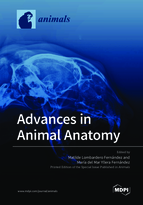Advances in Animal Anatomy
A special issue of Animals (ISSN 2076-2615). This special issue belongs to the section "Animal Physiology".
Deadline for manuscript submissions: closed (31 March 2021) | Viewed by 96735
Special Issue Editors
Interests: veterinary sciences; anatomy
Special Issues, Collections and Topics in MDPI journals
Interests: animal anatomy; embryology; welfare, behaviour and anatomy of laboratory animals; applied anatomy of exotic animals; veterinary embryology
Special Issues, Collections and Topics in MDPI journals
Special Issue Information
Dear Colleagues,
Knowledge of veterinary anatomy (as a basic science) is a prerequisite to master clinical (and some preclinical) disciplines and, subsequently, veterinary practice. Fortunately, descriptive anatomy is no longer the only method of teaching veterinary anatomy, and instead, applied veterinary anatomy is providing additional value in practical and clinical study.
As the subject of veterinary anatomy is being progressively reduced in academic programs, only basic functional, comparative, and applied aspects are taught in depth, even though knowledge of certain other anatomy-related concepts may be of great interest in application. Hence, we aim to publish original research, as well as reviews, that improve our understanding of applied veterinary anatomy, particularly papers that address the following topics:
1- Applied anatomy of domestic animals (mammals and birds), which facilitates the use of different approaches and the recognition of structures in diagnostic imaging or which helps in the comprehension of animal physiology.
2- Anatomy of wild animals, which could be very helpful to specialized veterinarians, researchers, and technicians to maintain the welfare of animals in zoos and wildlife recovery centers.
3- Anatomy of new companion animals, focused on the less well-known species that are being introduced into homes and require veterinary assistance, mainly because they are not adapted to life in captivity. Knowledge of their anatomy is essential, specifically in the following areas:
3.1- Diagnostic imaging to facilitate the recognition of the bones, viscera, and vessels in order to make a correct diagnosis.
3.2- Access to their superficial venous system that would allow for the taking blood samples or treatment administration (drugs/rehydration by dropper, etc.).
3.3- Clinical interventions (intubation, surgery, etc.) performed to avoid damaging vital structures.
3.4- Their anatomical adaptations to the environment during evolution and the pathologies derived from displacement from their habitats and life in captivity.
Additionally, apart from anatomical knowledge, the preservation of dissected specimens or their viscera is essential for the following:
1- Teaching in faculties/schools of veterinary medicine, as well as exhibiting specimens in anatomical museums, to avoid long and meticulous dissections and to reuse dissected specimens as much as possible.
2- The study of the anatomy of the new companion animals, of which there are few specimens available for studying.
The most used conservation method during the 20th century was formaldehyde (used in different concentrations or as part of fixative solutions), which must be abandoned due to its carcinogenic potential and powerful irritant effect on the eyes and airways. In addition, formaldehyde modifies considerably the color and consistency of tissues, creating confusion about the normal macroscopic appearance. Furthermore, it causes muscles to become rigid, reducing the physiological movement of joints, which is essential for teaching future veterinarians and technicians.
In recent years, new preservatives have been tested to minimize such drawbacks, such as the use of saturated saline solution; therefore, we also invite our colleagues to submit contributions describing their advances in preservation methods that will surely improve the practical study of anatomy.
Prof. Dr. Matilde Lombardero Fernández
Prof. Dr. María del Mar Yllera Fernández
Guest Editors
Manuscript Submission Information
Manuscripts should be submitted online at www.mdpi.com by registering and logging in to this website. Once you are registered, click here to go to the submission form. Manuscripts can be submitted until the deadline. All submissions that pass pre-check are peer-reviewed. Accepted papers will be published continuously in the journal (as soon as accepted) and will be listed together on the special issue website. Research articles, review articles as well as short communications are invited. For planned papers, a title and short abstract (about 100 words) can be sent to the Editorial Office for announcement on this website.
Submitted manuscripts should not have been published previously, nor be under consideration for publication elsewhere (except conference proceedings papers). All manuscripts are thoroughly refereed through a single-blind peer-review process. A guide for authors and other relevant information for submission of manuscripts is available on the Instructions for Authors page. Animals is an international peer-reviewed open access semimonthly journal published by MDPI.
Please visit the Instructions for Authors page before submitting a manuscript. The Article Processing Charge (APC) for publication in this open access journal is 2400 CHF (Swiss Francs). Submitted papers should be well formatted and use good English. Authors may use MDPI's English editing service prior to publication or during author revisions.
Keywords
- applied veterinary anatomy
- domestic species
- exotic pets
- wild animals
- gross anatomy
- anatomical preservation
- dissection








